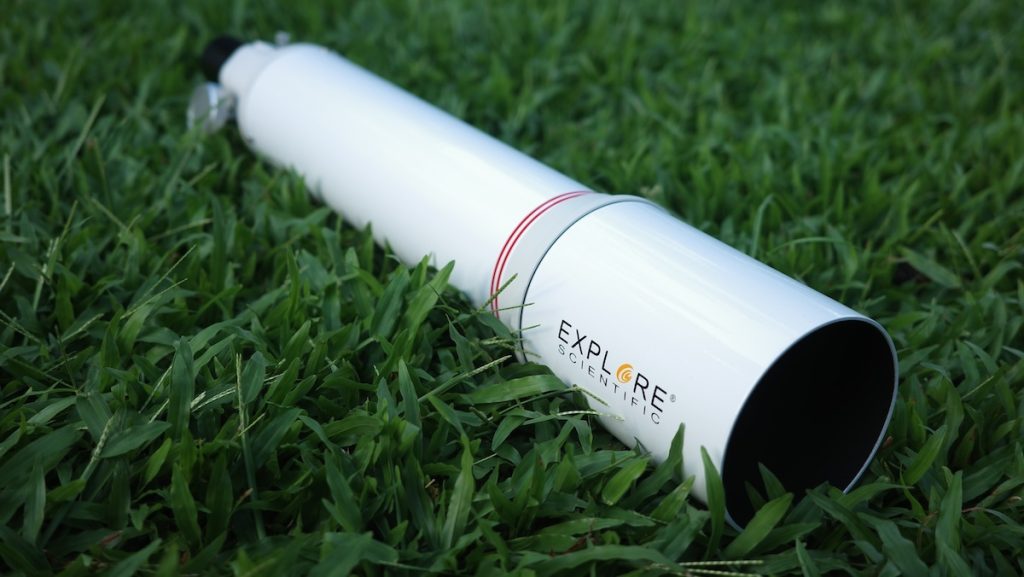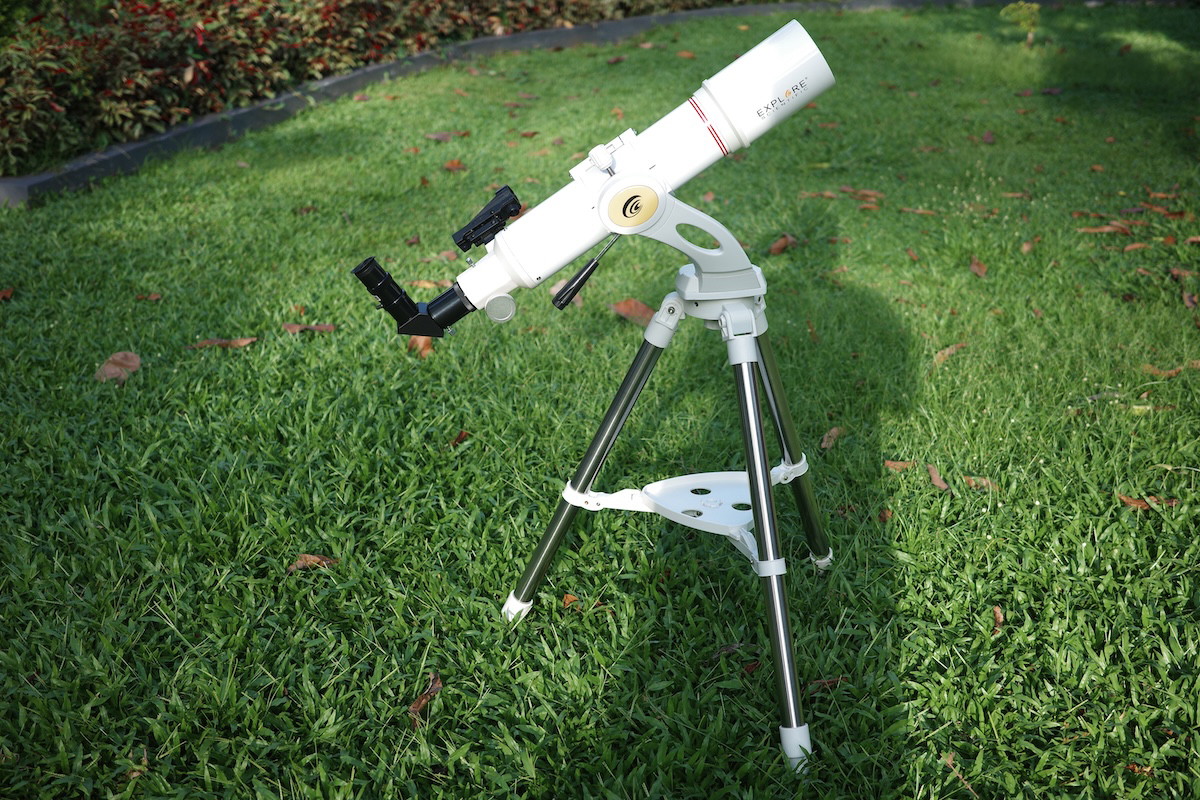The Optical Tube & Optics

Low focal ratio refractors tend to have lots of chromatic aberration, especially as they increase in aperture size. At a focal ratio of f/8 with only 80mm of aperture, with the FirstLight AR80, I observe only moderate chromatic aberration on bright targets such as the Moon, planets, and bright stars. It is not enough to severely impede the sharpness of my views.
The optics of the FirstLight 80 are of good quality and in my testing, it performed as expected for a telescope of this size.

The included 1.25” plastic rack-and-pinion focuser is pretty standard for cheaper and smaller entry-level telescopes. The rack-and-pinion design has some slop and I can’t hold most of my expensive and heavy wide-angle eyepieces in it. But since such eyepieces cost more than the FirstLight AR80 itself, I guess this is unlikely to be of much concern for the majority of this telescope’s users.

The FirstLight AR80 attaches to the Twilight Nano mount with a clamshell that wraps around the tube and is bolted to a Vixen-style dovetail rail. I can adjust the tube cradle to rotate the eyepiece/finder to my preferred position as well as slide the tube backwards and forwards for proper balance.

Accessories
What I’m not fond of is that the accessories included with the Explore Scientific FirstLight telescopes are a far cry from high quality, though there are worse options out there.
The provided 1.25”, 25mm Super Plossl (26x) eyepiece is okay. But it uses a lot of plastic and has an oddly recessed eye lens, both making it a lot less comfortable for me to look through than it should be. The eyepiece’s apparent field of view of 50 degrees translates to a true field of view of 1.9 degrees at 26x magnification. That’s a fairly wide field of view, which is just under 4 times the angular diameter of the full Moon. However, I don’t consider 26x to be enough for planetary observing or high-resolution views of the Moon, and the 25mm Plossl, as I’ve experienced, has a lot of glare and internal reflection issues.

The star diagonal included with the FirstLight AR80 and other scopes from the FirstLight line is a 1.25” mirror diagonal with a plastic housing. The mirror is pretty low quality, and from my extensive experience, I can tell that some mild astigmatism can be induced by the out-of-flat mirrors often installed in these diagonals. I also picked up a lot of scattering from the cheap mirror coatings, which is being worsened by the internal reflections inside the plastic body and the 25mm Plossl eyepiece.

The red dot finder provided with the FirstLight telescope slides into a non-standard shoe design that only Explore Scientific uses, making using any of my other finderscopes with it difficult. It has a slightly tinted window, which I guess is a consequence of being originally manufactured for non-astronomical purposes. I sometimes have trouble with this bracket being aligned with the telescope, but otherwise, it suffices for aiming the FirstLight AR80.

The Twilight Nano Alt-Az Mount
The sleek, rock-solid Twilight Nano is exceptionally high-quality for such an inexpensive product.

The optical tube is attached to the side of the Twilight Nano’s altitude (up-down) axis instead of above it, like a typical photo tripod. This helps keep the telescope from falling over when I point it high at the sky. Most cheap alt-azimuth mounts I’ve encountered are built like photo tripods or are extremely spindly fork mounts, which are unsteady and hard to aim.

I aim the Twilight Nano just by pushing it around. A handle is attached for finer adjustment, but there are no clutches or slow-motion cables. However, I feel that it is nearly as smooth as a Dobsonian, so I don’t think making fine adjustments is a huge challenge.
Should I buy a Used FirstLight AR80?
I don’t particularly like that the FirstLight AR80 has a lot of plastic components, which are easily damaged, but a used one in good shape makes for a fine scope as long as it either comes with additional accessories or if you don’t mind spending the money to upgrade one.
I’d also advise you to make sure that the objective lens is free of damage and that the teeth on the focuser aren’t stripped.
Alternative Recommendations
The FirstLight AR80 isn’t our top pick in its price range; there are a few other scopes I might recommend you consider instead, though most of them are reflectors.
$200-$350
- The Sky-Watcher Heritage 150P has nearly double the resolving power and just under 4 times the light-gathering ability of the FirstLight AR80, along with a pair of high-quality eyepieces and a steady, easy-to-aim tabletop Dobsonian mount. The tube collapses for portability, too.
- The Sky-Watcher Heritage 130P offers many of the same features as the Heritage 130P but with a slightly smaller aperture and significantly lower price tag. It is an equally excellent telescope to its larger sibling and boasts a nearly as large performance advantage over the FirstLight AR80.
Aftermarket Accessory Recommendations
If you replace the cheap, low-quality diagonal that came with the FirstLight AR80, sharpness and contrast at the eyepiece get much better. Either a dielectric mirror diagonal or prism is fine for the job. The Celestron 94115, a prism diagonal, is one of the cheaper options and my favorite for equipping low-cost telescopes with 1.25” focusers.
With the FirstLight AR80, a 32mm Plossl eyepiece will be sharper and have a wider true field than the stock 25mm Plossl. It provides a magnification of 20x and a true field of 2.6 degrees, or over 5 times the angular diameter of the full Moon. At the other end of the spectrum, a 6mm “goldline” eyepiece will produce 107x magnification with the FirstLight AR80, about as high as I’d probably use but ideal for lunar, planetary, and double star viewing. At least one or two additional eyepieces—perhaps something around 15mm focal length (43x), like a 15mm SWA—will bridge the gap between low and high magnifications for lunar and deep-sky viewing.
Seeing with the FirstLight AR80
The FirstLight AR80 is decent for both planetary and deep-sky viewing, offering a wide field of view but without too much in the way of open clusters.
I can view dozens of bright open star clusters, like the Double Cluster, the Pleiades (M45), or the Wild Duck cluster (M11), throughout the night sky, even from fairly light-polluted locales. However, with only an aperture of 80 mm, globular star clusters remain unresolved fuzzy balls. While a larger aperture is required for viewing planetary nebulae, the Dumbbell (M27) is sufficiently bright and large to be recognized with the FirstLight AR80, along with the dimmer Helix Nebula, under dark skies. I can also observe the Ring (M57) and the Blinking Planetary at higher magnifications.
With the FirstLight AR80, I can enjoy the Orion Nebula (M42), the Lagoon (M8), and the Swan (M17) even from a suburban area. However, dark skies and/or a UHC filter give the best views and let me see more nebulae like the Trifid (M20) or Eagle (M16). The fainter but gigantic Rosette Nebula and North America Nebula can be seen with dark skies and are brought out best by a UHC filter. The massive Veil Nebula supernova remnant requires a good UHC filter to be seen but delights at low power with the AR80, stretching well past a singular low-power field of view.
An 80mm telescope is insufficient to show me much in the way of galaxies. Under dark skies, I’m just barely able to see the dust lanes and orbiting companions of Andromeda (M31), along with the eponymous cigar shape of M82 and its dust lanes. Most other galaxies remain dim fuzzy streaks, orbs, and ovals, often hard to see at all, though I can still just barely glimpse a couple dozen galaxies within the Virgo Cluster at low magnification.
The FirstLight AR80 does a good job on planets with a suitable high-power eyepiece.
- I can see the phases of Mercury and Venus, as well as the polar ice caps and a few dark markings on Mars when the latter is at its closest to Earth.
- The Moon shows plenty of detail, such as ridges, mountain ranges, and countless craters.
- Jupiter’s cloud belts and four large moons can be seen; steady seeing can allow me to resolve smaller cloud details, including the Great Red Spot as well as the disks and shadows of the moons when they transit in front of Jupiter.
- Saturn’s rings and the Cassini Division within them are a delight, and the FirstLight 80 also has no trouble resolving some of Saturn’s dull cloud bands along with at least a handful of its many moons, with the most obvious being Titan and Rhea.
- Uranus and Neptune are little more than unresolved fuzzy dots, though Uranus is noticeably not a star at higher magnifications. The moons of Uranus and Neptune, as well as even dimmer Pluto, are beyond the reach of a telescope with only an 80-mm aperture.



